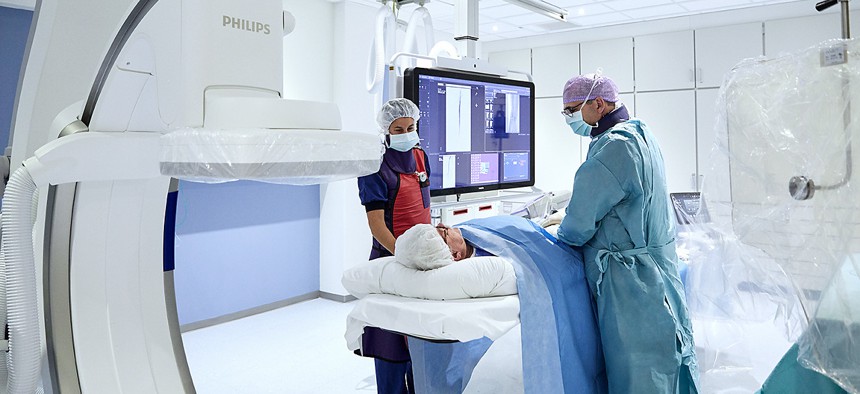sponsor content What's this?

Philips’ Azurion image-guided therapy platform Photo courtesy of Philips
Building Stronger Public Health through the Pandemic and Beyond
The COVID-19 pandemic has revealed the need to create a more resilient public healthcare system — and laid the groundwork for a more flexible, connected and streamlined future.
Presented by
Philips

In recent months, the public healthcare system has faced an unprecedented level of disruption. As the impacts of the COVID-19 pandemic continue to ripple across the nation, the public health sector is grappling with the need to effectively and safely treat large numbers of the population, communicate ever-changing information, contend with mounting levels of data and manage a new operational landscape.
“Our health system was built to serve about 5% of the population at any given time. Obviously, numbers have moved far beyond that. And from that, what has come to light is the need for a more resilient and adaptable healthcare system that can more easily scale in times of crisis,” says Paula Cobb, head of Global Strategic Marketing for Connected Care at Philips, which works with the Defense Department and Department of Veterans Affairs to provide health solutions that aim to enhance healthcare workflows and communication at VA hospitals and other federal health facilities.
The upshot is that many of the technologies necessary to create a more resilient healthcare system are already available, and with the pandemic driving large operational changes, providers are moving to adopt them more rapidly than ever before.
“The technology, like telehealth, is here. It has arrived. And now it’s less about adoption and more about positioning providers to better use this technology, both for this moment in history, and for the future,” says Nathan Naylor, vice president for Veterans Healthcare, Philips North America.
Telehealth to the Rescue
Indeed, health technology like telehealth, patient monitoring and artificial intelligence-fueled tools promise to create a more streamlined, cost-effective health system. This news isn’t new: Digital transformation has been on the agenda for healthcare organizations for the past few years, but the COVID-19 pandemic put many of those plans into hyperdrive. As hospitals across the U.S. saw huge capacity increases, many other healthcare organizations saw in-office patient traffic drop and operational needs shifted dramatically across the board. While many care facilities have previously been slow to adopt new tools and systems, the sudden need to shift has presented an opportunity for providers to rethink care delivery.
“From the positive side of it, it's really been an eye opener for the healthcare system to look at how we can break the model and do things differently. Providers are seeing that they need to open their data, find ways to share more information, leverage technology in ways that we haven't leveraged it in the past,” says Cobb, who has noticed a sudden willingness across the industry to share data and information more openly than ever before.
Indeed, the industry quickly turned to technology like telehealth to bridge the gap so providers could continue to safely deliver care to their communities.
“The Department of Veterans Affairs must provide healthcare to 9 million veterans, and during COVID-19 that has meant keeping veterans at home as much as possible. Telehealth has allowed them to do that,” says Naylor. “Before COVID, the VA was averaging about one thousand telehealth visits a day. Soon, they will likely surpass 50,000 appointments per day.”
And as the pandemic wanes, this willingness to embrace virtual visits will help to expand and enhance care delivery across the system.
“Telehealth visits aren’t meant to replace in-person visits, but instead to augment them. If you are able to see your doctor in a way that is less disruptive to your day, you’re likely to do it more often, and so it creates more touchpoints between the patient and the doctor. It creates more longitudinal data that can give your provider a more accurate picture of your health and, in turn, help to diagnose a patient more accurately and, possibly, earlier,” Cobb said.
A Connected, Secure Future
Creating that larger and more accurate picture of a person’s health is key to establishing a future where care is more streamlined and accurate. But it only starts with more touchpoints between patient and physician. As providers and patients alike adopt more available and secure digital tools, like wearables, the pool of available health data will continue to grow and create opportunities for a more connected care model.
“The pre-COVID model relied heavily on the patient to tell the doctor what has been happening with them in the time between visits. But with access to connected devices that can securely monitor health data, that health information is going to be always on; it'll give that provider and that caregiver the opportunity to see that data on a consistent basis,” says Naylor, noting that this is particularly important for the veteran community, which has often been exposed to activities that have given them the potential for long-term health issues.
Moreover, as tools like AI enter the picture, they can be leveraged to recognize patterns and monitor irregularities, possibly catching problems before a major incident happens. In fact, Philips is working with the Defense Department on a research project that aims to evaluate an AI-based early warning system for infectious disease, noninvasively monitoring a serve member’s health, helping to ensure troop readiness and mitigate disease spread.
It’s initiatives like this that help to shift the care model toward preventative measures, which not only keep people healthier but reduce costs across the healthcare system as a whole. In fact, 90% of annual healthcare expenditures in the U.S. are for people with chronic and mental health conditions, according to the Centers for Disease Control.
“Connected care — as it continues to roll out — will help people stay healthier. And that itself will drive down costs,” says Naylor.
And as healthcare facilities look to shift operations to serve their populations most effectively, connected care can help with that, as well, offering providers a better look at the populations they serve and what tools they might need to better serve that population.
“Right now, every hospital is trying to be everything to everybody, but what we really need to do is look at which area is seeing more births, or hip replacements or leg breaks and then provide specialized clinics in places where the populations will actually use them,” says Naylor. “By changing this distribution and making it an ecosystem of care, you can make it easier to serve the population where they are and equip doctors with the tools and training they need.”
Partner in Public Health
When it comes to creating a resilient, connected ecosystem of care and tapping into the benefits it provides, however, public health agencies will need to ensure that they are investing wisely and laying a platform that will allow them to continue growing care access.
A trusted partner can help with that.
“At Philips, our only focus is healthcare. We really believe in healthy living — and we only invest in tools and the education to provide that,” says Cobb. “We deliver care in any type of setting and have invested in the tools and capabilities allowing us to take those cost-effective care options and provide flexible and scalable business models for them.”
Philips looks to help providers not only meet today’s operational needs, but also to transition to a more connected, predictive and personalized future of care delivery.
Cobb adds: “We really are best positioned to create a more connected and secure ecosystem of care, so that people can tap into the systems and tools that will create a more resilient future.”
Learn more about how Philips can help your organization tap into a more resilient care ecosystem.
This content is made possible by our sponsor Philips; it is not written by and does not necessarily reflect the views of GovExec’s editorial staff.
NEXT STORY: How to Advance the Paperless Government Mission






